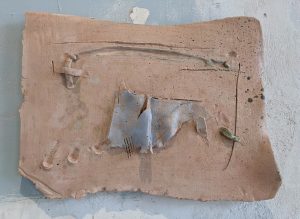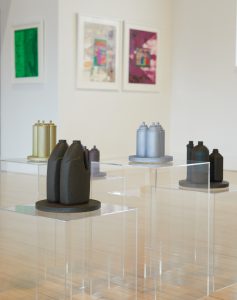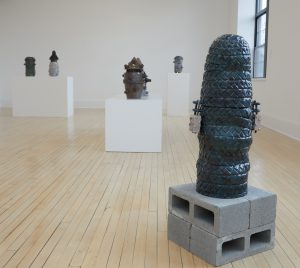Pushing the Boundaries of Ceramic Art at KinoSaito Art Center
Ceramics has been around for thousands of years. In fact, ceramic sherds are the most common artifacts used by archeologists to understand the culture and technology of a locale’s ancestors.
Through May 7, KinoSaito Art Center focuses on the art of ceramics by presenting three solo shows by artists who pushes the boundaries of the medium: Kikuo Saito (Pictorial Clay), Patrice Renee Washington (Tendersweet) and Murray Hochman (New Dimensions).
“Nurturing experimentation in every form and medium” is at the core of KinoSaito mission, which was established in 2021 to preserve legacy of its “founding muse,” Kikuo Saito, who died in 2016.
Saito was a Japanese-American abstract artist most associated with Color Field painting, which was prominent in 1960s New York, and his work on theatrical sets, costumes and props. However, in Pictorial Clay, a series of ceramic wall reliefs from the 1980s, Saito experimented with wet clay slabs – bending, incising and adding color glaze to create objects that, despite their three-dimensionality, evoke his abstract paintings from that time.
Regardless of the stylistic similarities between Saito’s paintings and his clay pieces, in paintings, color is the primary component, summoning emotions and drama; in stoneware, it is the sculptural manipulations, such as folded corners, torn edges, incisions and glaze luster that often pull the viewer in. For instance, despite its subdued pastel colors, Wooden Camel is an expressive piece due to its wavy “canvas” shape, uneven, rough edges, protruding clay additions and traces of finger marks that are reminiscent of the gestural nature of Abstract Expressionism.
Similar to Saito, Patrice Renee Washington’s Tendersweet goes beyond usual practices of ceramic art. In her case, despite the intricate craftsmanship involved with her sculptures, it is the context that uplifts the decorative nature of pottery. Washington explores race and power in a historical context. For instance, in delftware-inspired tile artworks, the artist surveys Black resilience in the framework of Dutch Colonialism. The tiles depict notable African-American historical figures as well as symbolism of the boll weevil beetle that was a catalyst to the Great Migration. At the same time, the nature of the material, the clay, is an important cultural signifier.
As KinoSaito Manager Michael Barraco says: “Ceramic seems fragile, but lasts for years.”
The notion of longevity also permeates the artworks in Murray Hochman’s New Dimensions. Hochman is redefining art materials by upcycling plastic and metal scraps and transforming them into colorful wall reliefs and sculptures. Inspired by Han Dynasty ceramic vases, Hochman utilizes spray paint and solvents to transform spray cans and plastic bottles into pottery-like decorative vessels.
Barraco explains that Hochman is toying with the notions of high and low art and, as a Korean War veteran, knows how to apply camouflage to create “illusion of precious materials when in reality you are looking at recycled junk.”
A one-hour guided docent tour led by one of the Center’s trained educators will explore all three solo shows on April 23. A gallery walkthrough with Patrice Renee Washington, as well as a conversation between Washington and Olga Dekalo, who curated Tendersweet, will take place on April 29. In addition, every Sunday afternoon in April, a Pinched Pot workshop leads children and families through making pots, cups and bowls that are inspired by the ceramic sculptures on display in the galleries.
———————
Yana Rolnik is a freelance art historian and full-time Director of Software Engineering at Confluence Technologies. She has a Bachelors in Computer Science, Masters in Art History, and is pursuing Masters in Entrepreneurship in the Arts.
Photo Credit: Kikuo Saito, Pictorial Clay Installation View. Photography by Chika Kobari courtesy of KinoSaito
 |  |  |







